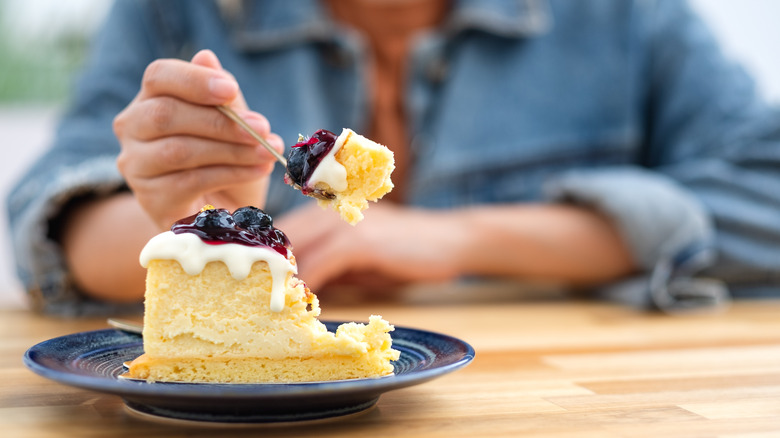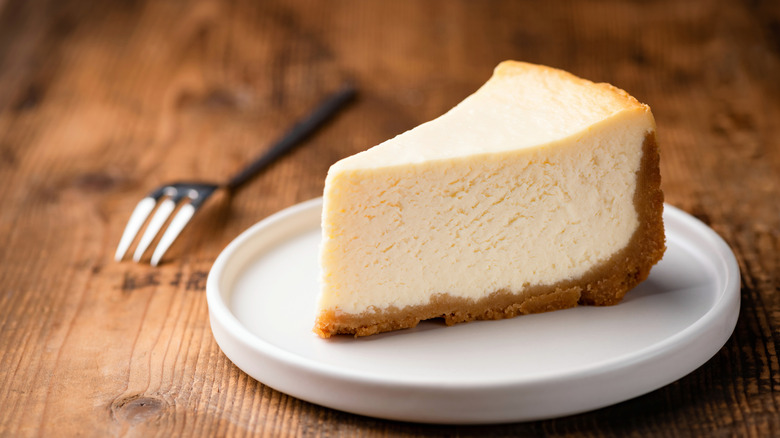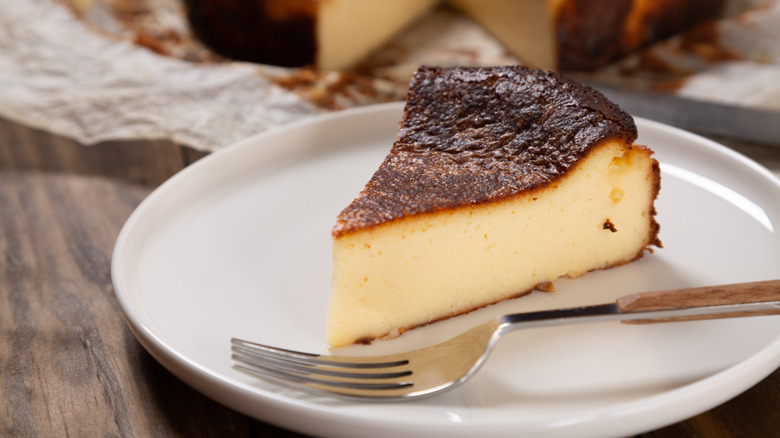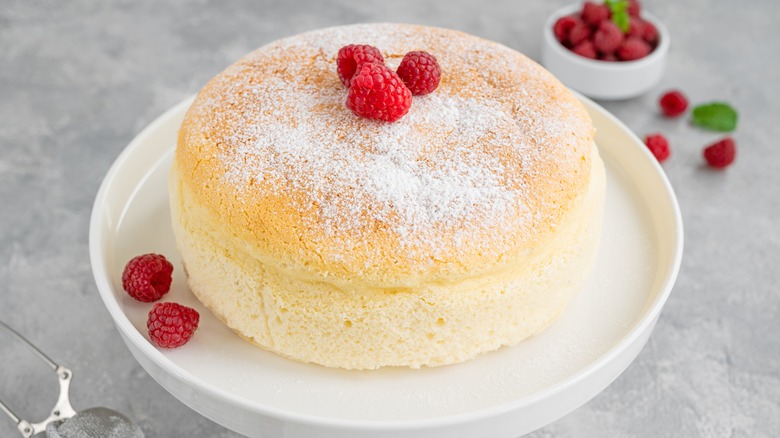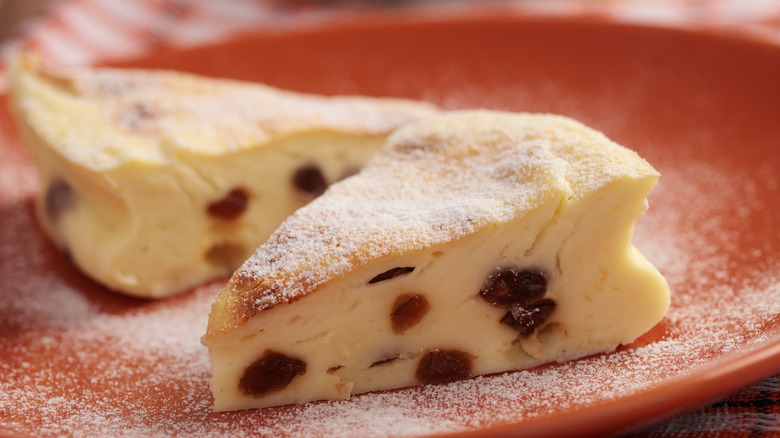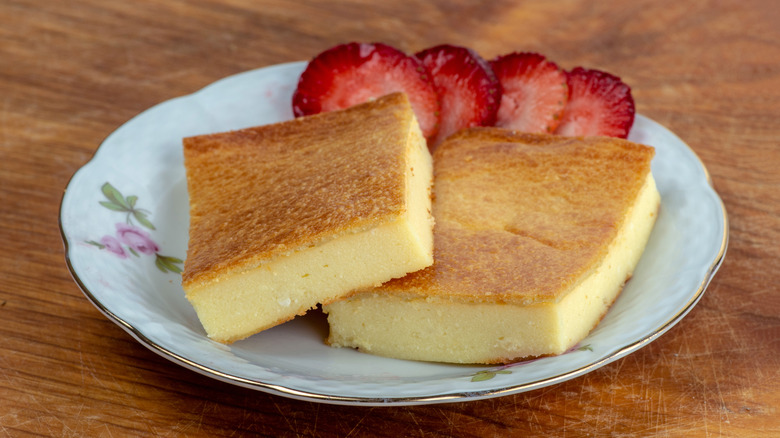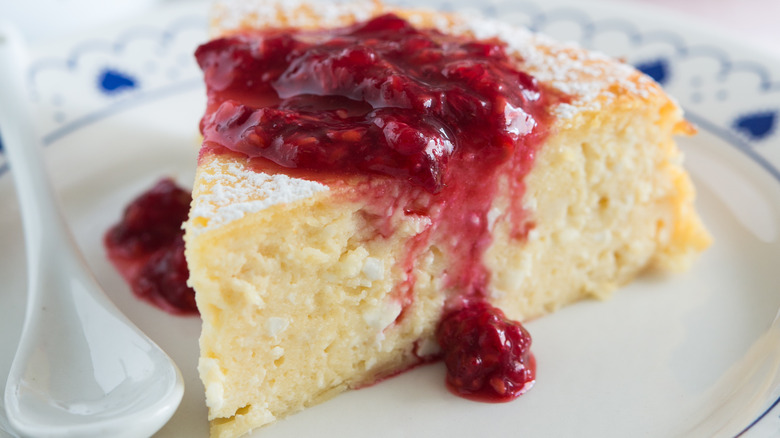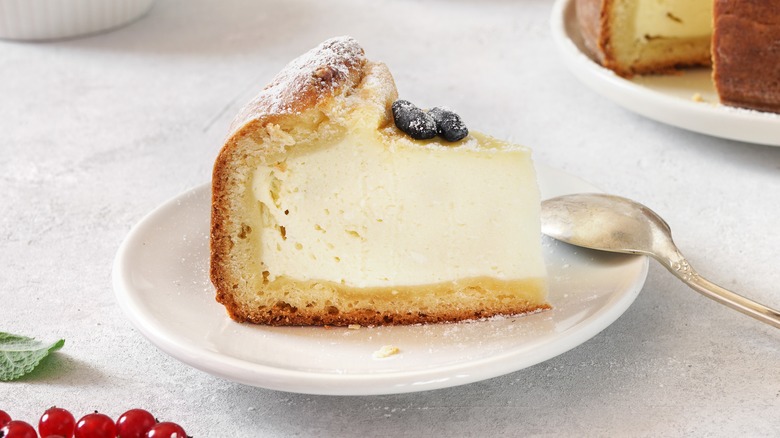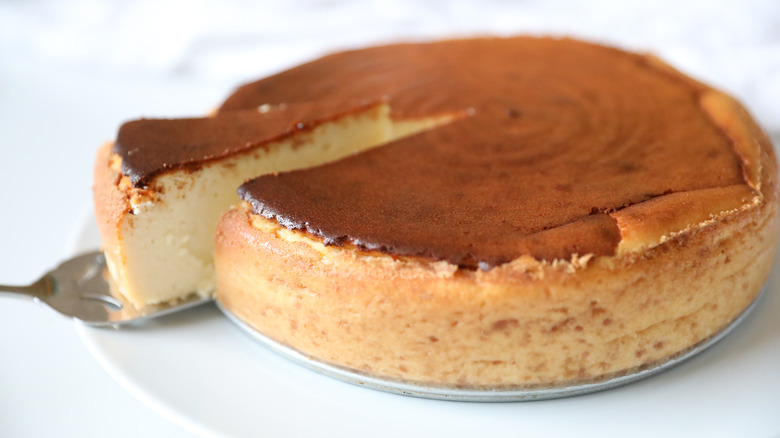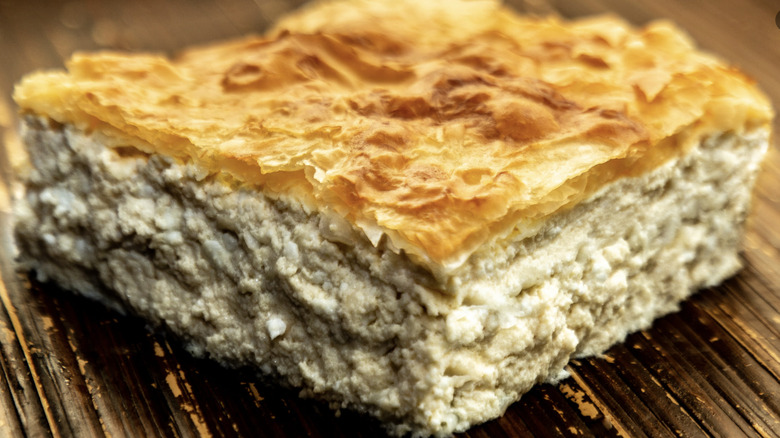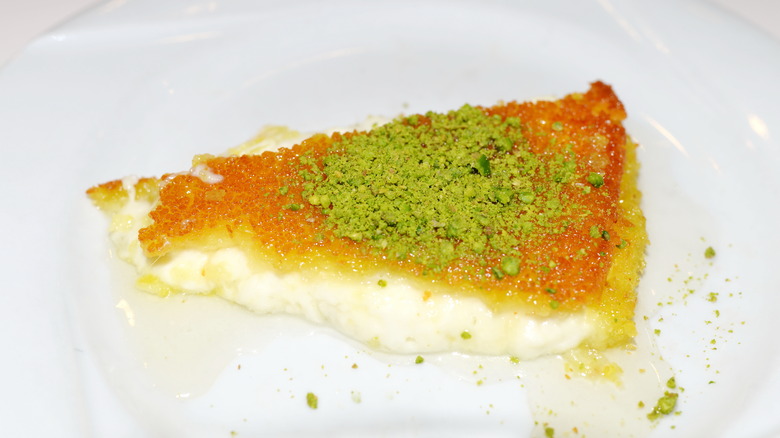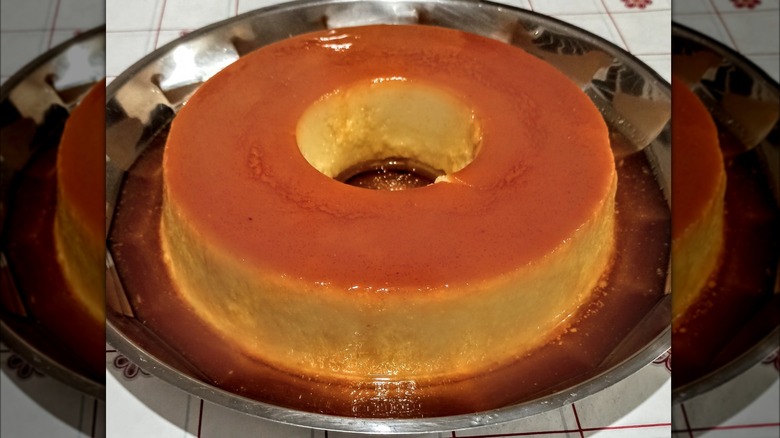The Ultimate Guide To Cheesecakes From Around The World
The first cheesecake is believed to have originated thousands of years ago on the Greek island of Samos. Although anthropologists uncovered 4,000-year-old cheese molds in the region, it's highly probable that dairy predates even this ancient discovery. Historically, cheesecake was regarded as an excellent source of energy and was apparently served to athletes during the inaugural Olympic games in 776 B.C. at Olympia in southern Greece.
While the first versions of cheesecakes were likely made from wheat, flour, honey, and cheese, modern-day recipes have evolved significantly, resulting in an array of diverse variations of the sweet treat across the globe. Today's cheesecakes reflect the culinary preferences of different regions worldwide, with many recipes incorporating local ingredients to create distinctive flavors and textures unique to the cuisine.
Ready to find out more about the diverse flavors and ingredients that make each cheesecake special and worth tasting? Check out our guide to cheesecakes from around the world.
New York cheesecake
What sets the New York cheesecake apart from the pack is its star ingredient, cream cheese. Combined with heavy cream, sugar, and eggs, it's the cream cheese that gives this dessert its rich and velvety texture. Some variations of the recipe also substitute cream cheese with sour cream to improve the dessert's freeze-thaw stability. While purists prefer their New York cheesecake plain, it's not uncommon for the sweet treat to be adorned with toppings such as strawberries or other fruits. The dessert's base is usually made with graham cracker crumbs combined with butter, sugar, and a touch of salt.
While the Philadelphia cream cheese brand was already around in 1875, the ingredient wasn't incorporated into the New York cheesecake recipe until the early 1900s. The invention of the cake is often attributed to Arnold Reuben — the very same Reuben who created the Reuben sandwich in the 1920s. According to a popular story, Reuben came up with the idea for the recipe after being served a cheese pie at a dinner party.
Basque burnt cheesecake
Despite its scorched appearance, Basque cheesecake features a silky and airy interior. The caramelized top and jiggly interior occur because the cake is normally baked at a high temperature. The great news for those wishing to replicate the crustless cake at home is that it's composed of just five ingredients: cream cheese, eggs, sugar, cream, and flour.
Basque cheesecake has been getting a lot of attention lately, and The New York Times even called it "The flavor of the year" in 2021. More recently, the dessert appeared in one of the elimination challenges on Season 2 of "Crime Scene Kitchen." Basque cheesecake has also been embraced in Turkey, becoming a beloved choice in cafes and pastry shops. In addition, the dessert has also made a name for itself in Japan, where it's frequently adapted to local tastes.
This type of cheesecake is relatively new on the dessert block, having originated at La Viña cafe in San Sebastian, a coastal city in the Basque region of Spain in the 1980s. The dish was invented by chef Santiago Rivera, the son of one of the cafe's founders, who enjoyed experimenting in the kitchen. "On my days off, I would come to work. Everything would be empty, and I could work and do tests in the kitchen," Rivera told National Geographic. "Among these tests, I tested the cheesecake and would make it every now and then, until people started asking for it more and more."
Japanese cheesecake
There's a good reason why Japanese cheesecake is also sometimes referred to as cotton cheesecake or soufflé cheesecake. The crustless treat is incredibly light and spongy due to the fact that the egg whites are beaten before they are folded into the cream cheese and other ingredients. The dessert contains a modest amount of sugar, which is mostly used to balance the tartness of the cheese rather than to sweeten the cake. Akira Toyama, the baker at Only Cheesecake in Melbourne, Australia, told Broadsheet that Japanese cheesecake is trickier to make than most of its international counterparts, explaining, "When it's baking in the oven, it's baked in hot water with a water bath."
While Japan initially acquired a taste for cheesecake when American soldiers introduced it to the country during World War II, Japanese cheesecake didn't make its debut until the 1960s. The dessert was invented by chef Tomotaro Kuzuno, who developed a liking for German cheesecake during a trip to Berlin. Upon returning home to Japan, Kuzuno came up with his own version, and the Japanese cheesecake was born. Today, the fluffy treat is enjoyed across Japan and has even gained some international popularity.
Sernik cheesecake
Sernik is unique due to its filling, which is made with a type of Polish white cheese called twarog. Made from cow milk, twarog is a curd cheese with a slightly sweet and tart flavor that's often used in Polish dishes, such as pierogi. While some recipes keep the cheesecake filling simple, others call for chopped candied fruit peel or raisins, enhancing the cake's sweetness and texture. Some recipes also call for a layer of fruit jelly to elevate the treat's flavor and visual allure. Unlike other cheesecakes that are usually made with a base of crushed biscuits, sernik features a shortcut pastry crust.
Sernik is said to have originated in the 17th century when King Jan III Sobieski brought a version of the recipe back to Poland after winning against the Turks at the Battle of Vienna. Today, sernik is commonly enjoyed to celebrate Christmas and other festivities.
Fiadone
Fiadone is the pride of Corsica, a French island in the Mediterranean Sea between France and Italy. Made from sheep or goat cheese called brocciu, eggs, sugar, and fruit brandy (locally called eau-de-vie), the cake is both sweet and tangy in flavor. The filling can be made with ricotta cheese instead of brocciu, and it sometimes contains lemon zest and lemon juice. Its velvety texture stands in pleasant contrast to the dessert's lightly browned crisp exterior. Corsican fiadone cheesecake tends to be thinner than its counterparts from other countries and is usually served cold.
This dessert transcends mere flavors; it's a cultural treasure that resonates deeply with the hearts of Corsican locals. It stands as a culinary testament to the island's rich history and enduring customs. Passed down for generations, the sweet dessert is commonly enjoyed at family gatherings and other celebrations such as Easter and New Year's Eve.
Ostkaka
Hailing from Sweden, ostkaka cheesecake is rooted in regional traditions, with records referencing it that date back to the 16th century. Considering its variability, the sweet treat can be made following different recipes depending on its exact place of origin. The most famous version is Smaland ostkaka from the south of the country. The crustless dessert has an almond flavor and firm yet creamy consistency, and it is usually served lukewarm and topped with jam and whipped cream.
Ostkaka cheesecake is traditionally made with rennet, which is used to curdle fresh milk into curd cheese. The curds are then combined with other ingredients including eggs, cream, sugar, and chopped almonds. To simplify its preparation process without compromising the final result, modern recipes for ostkaka cheesecake usually call for cottage cheese. This modification has both made the treat more accessible to home chefs and preserved the essence of the traditional dish.
Käsekuchen
Käsekuchen gets its creamy texture from quark, a soft and velvety cheese with a taste profile that falls somewhere between cottage cheese and Greek yogurt. Just like its name suggests (quark translates to "fresh curd" in German), the cheese has a mild and delicate flavor. When making käsekuchen, quark can be substituted with pureed ricotta cheese or cottage cheese, depending on the recipe.
Aside from quark, recipes for käsekuchen typically include milk, eggs, and sugar. The dessert's filling is sometimes topped with assorted fruits and berries for added sweetness. It can also be dusted with powdered sugar. While käsekuchen was originally made without crust, nowadays the dessert often features a rich buttery crust made from crushed biscuits. Alternatively, the crust can be made with flour, butter, and sugar, or a yeast dough can be used. Käsekuchen cheesecake is typically eaten chilled, making it a refreshing choice on warm summer days.
Ricotta cheesecake
Italian desserts are revered around the globe, with tiramisu among the most popular. However, a lesser-known Italian gem is a ricotta cheesecake. Just like its name suggests, the main ingredient is ricotta cheese, a smooth, creamy, and mild-flavored dairy. As such, ricotta cheesecake tends to be lighter and dryer than cheesecakes made with cream cheese.
Apart from its primary component — ricotta cheese — the recipes for ricotta cheesecake vary. Some preparation methods involve mixing ricotta with milk while others require the addition of mascarpone cheese for a fluffier and creamier texture. Whatever you decide on, adding a fruit topping to the cheesecake is a big no-no in Italy, so don't try it if you're entertaining guests from the Mediterranean country. This being said, candied lemon is sometimes added to the dessert's filling for a tangy touch. Italian cheesecake isn't typically made with crust, although some recipes do incorporate it.
Tiropita
While some may argue that tiropita is more akin to a savory cheese pastry than a cheesecake, it's worth including it in our list of cheesecakes from around the globe because it showcases the versatility of cheese-based pies. The classic Greek pastry is typically made by layering sheets of phyllo dough and filling them with a blend of feta cheese, eggs, and occasionally ricotta cheese. The filling sometimes contains dill and parsley too. The pastry comes in a variety of shapes and sizes, from a circular cheese pie that's cut into individual slices to triangular packages of cheesy goodness.
Tiropita's distinctive crispy and delicate texture is largely due to the use of phyllo pastry, also known as filo. While it can be easily purchased at your local grocery store, if you're making it from scratch it consists of a blend of flour, water, and oil or vinegar. Since each sheet of the pastry has to be paper-thin, it can be quite time-consuming to make.
Peynirli künefe
While there's little doubt that baklava is one of Turkey's most well-known desserts, the country has a lot up its sleeve in the sweets department. Peynirli künefe has numerous variations, but at its most basic it's composed of two layers of thin pastry strands and a mild local cheese similar to fresh mozzarella. The dessert is sometimes served with kaymak, which is a soft Turkish clotted cream.
The pastry is usually drenched in melted butter and baked until crispy and golden. Once out of the oven, it's covered with a syrup made from granulated sugar, water, and lemon and sprinkled with chopped pistachios.
Unlike many other cheesecakes, peynirli künefe is served hot to ensure that the cheese between the pastry strands is deliciously soft and gooey. There are other versions of the dessert, including those that utilize semolina pastry dough for the crust, which is made with water instead of eggs. Another variation of the dessert is infused with the essence of orange blossom water or rose water and uses grape molasses to impart it with a beautiful golden hue.
Pudim de queijo
Translated to cheese pudding in Portuguese, pudim de queijo is probably more similar to flan than it is to a cheesecake. However, while flan is typically made with eggs, milk, sweetened condensed milk, and flavored with orange, vanilla, or coffee aromas, pudim de queijo is a slightly different kind of beast ... or rather cake.
Composed of eggs, sugar, and grated or crumbled goat cheese, pudim de queijo is creamier than traditional flan. In addition, the slightly tangy flavor of goat cheese adds a unique twist to this dessert, making it a favorite among cheese enthusiasts. Popular in Brazil, this sweet dessert is relatively easy to make and can be baked as either a single round cake or in individual portion-sized cups.
Don't confuse pudim de queijo with other Brazilian baked treats that feature similar names, like pão de queijo, a tapioca-flour-based cheese bread with a crispy exterior and chewy interior.
